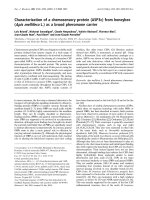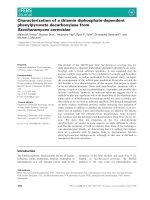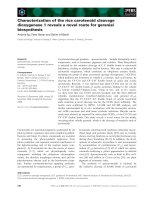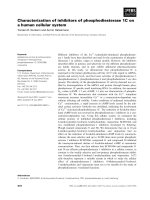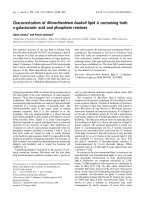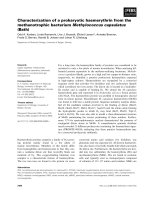Báo cáo khoa học: Characterization of a high-affinity binding site for the pea albumin 1b entomotoxin in the weevil Sitophilus ppt
Bạn đang xem bản rút gọn của tài liệu. Xem và tải ngay bản đầy đủ của tài liệu tại đây (201.56 KB, 7 trang )
Characterization of a high-affinity binding site for the pea albumin 1b
entomotoxin in the weevil
Sitophilus
Fre
´
de
´
ric Gressent, Isabelle Rahioui and Yvan Rahbe
´
UMR 0203 INRA/INSA de Lyon, BF2I (Biologie Fonctionnelle, Insectes et Interactions), INSA Ba
ˆ
timent Louis Pasteur,
Villeurbanne, France
The toxicity of the pea albumin 1b (PA1b), a 37 amino-acid
peptide extracted from pea seeds, for cereal weevils (Sito-
philus oryzae, Sitophilus granarius and Sitophilus zeamais)
was recently discovered. The mechanism of action of this
new entomotoxin is still unknown and potentially involves a
target protein in the insect tissues. This work describes the
characterization of a high-affinity binding site for PA1b in
a microsomal fraction of Sitophilus spp. extracts. Purified
PA1b was labeled to a high specific radioactivity
(c. 900 CiÆmmol
)1
)using
125
I, and the iodinated ligand was
found to be biologically active. Binding of this ligand to the
microsomal fraction of S. oryzae extract was found to be
saturable and reversible, with an affinity (K
d
)of2.6n
M
,and
a high maximal binding capacity (B
max
)of40pmolÆmg
)1
of
protein. A binding site displaying similar characteristics was
detectable in the five susceptible weevils strains tested, as well
as in the pea aphid or in the fruit fly. However, no binding
activity was detectable in extracts from four S. oryzae strains
previously shown to be resistant to the toxin through a
recessive monogenic mechanism. Therefore, we suggest
that this binding site might be involved in the mechanism
of action of PA1b.
Keywords: binding site; pea albumin 1b; Sitophilus;cystine-
knot; leginsulin.
The cereal weevils (Sitophilus oryzae, Sitophilus granarius
and Sitophilus zeamais) are major pests of stored grains. At
present, the use of chemical insecticides is the main answer
to the damage caused by stored product pests, inducing
ecotoxicity problems and the occurrence of resistance within
insect populations. An alternative for controlling insects is
physical methods, such as cooling or the use of nitrogen or
carbon dioxide atmosphere. However, these methods are
expensive and not always applicable. Plant protection also
takes advantage of the genetic resources residing in crop
plants to create resistant varieties, and of the use of
biological toxins to build up transgenic plants tolerant to
different insect species. The Bacillus thuringiensis toxins [1],
proteins belonging to the lectin family [2], or enzymes
inhibitors [3], are in use or being tested, but to date these
molecules are not adapted to grain protection against
weevils.
Therefore, the recent finding of a plant peptide lethal for
these insects has enlarged the possibilities for cereal grain
protection [4]. This peptide was purified and sequenced
from Pisum sativum seeds and, being previously known as a
seed albumin [5], it was named PA1b for pea albumin 1b.
PA1b is the result of the post-translational cleavage of the
albumin proprotein PA1, also releasing a second peptide
(PA1a). PA1b consists of 37 amino acids, with six cysteines
involved in three disulfide bonds which confer the toxin its
high stability. Biological activity is conserved when boiled,
and the peptide is resistant to digestion by trypsin [6] or by
bovine rumen fluid [7].
Although no primary sequence homologies could be
found with other proteins in the available databases, it
was recently established by NMR studies and molecular
modeling that PA1b belongs to the cystine-knot family [8].
Characterized only recently as a structural family [9],
cystine-knot peptides have now been identified from a
variety of sources (plants, fungi, animal venoms, insects),
and show very diverse biological activities (elicitor AVR9,
trypsin inhibitor, antimicrobial, antiviral or antifungal
activities, and many channel blockers [10]). A subfamily of
these, the cyclic cystine-knot peptides, also named cyclo-
tides, were investigated for their potential as new anti-
biotics or anti-HIV properties. PA1b was the first
entomotoxic cystine-knot peptide identified (peptidic
sequence and disulfide bridges are shown in Fig. 1), and
the interest of this structural family for insect targets was
reinforced by identifying the cyclotide kalata B1 as a
peptide active on larval growth of the Lepidoptera
Helicoverpa punctigera [11]. Moreover, PA1b might
belong to a multigenic family, as at least five isoforms
of the peptide exist in a single pea genotype and it seems
to be widespread in legumes [4,5].
Many cystine-knot peptides have inhibitory effects,
against channels, proteases, or a-amylase [10]. However,
to date, in vitro assaysusingPA1bfailedtorevealany
Correspondence to F. Gressent, UMR 0203 INRA/INSA de Lyon,
BF2I (Biologie Fonctionnelle, Insectes et Interactions), INSA
Baˆ timent Louis Pasteur, 69621 Villeurbanne Cedex, France.
Fax: + 33 4 72438534, Tel.:+ 33 4 72437982,
E-mail:
Abbreviations: PA1b, pea albumin 1b; BBI, soybean Bowman–Birk
inhibitor; E-64, trans-epoxysuccinyl-
L
-leucylamido(4-guanidino)-
butane.
(Received 21 February 2003, revised 24 March 2003,
accepted 8 April 2003)
Eur. J. Biochem. 270, 2429–2435 (2003) Ó FEBS 2003 doi:10.1046/j.1432-1033.2003.03611.x
enzyme inhibitory effect [4]. Therefore, the aim of the
present work was to investigate the mode of action of the
toxin, as part of a wider study to determine whether PA1b
could be a valuable tool for insect control. An important
point is to understand the molecular mechanisms of the
sensitivity to the toxin, since resistant strains do exist
naturally: the screening of up to 90 Sitophilus spp. strains for
the susceptibility to PA1b has revealed that three strains, all
belonging to the S. oryzae species, contained individuals
able to feed on pea seeds [12] and resistant to the purified
toxin. Other pest insects (the pea aphid Acyrthosiphon pisum
and the flour moth Ephestia kuehniella) were found to be
susceptible to the toxin, but the fruit fly Drosophila melano-
gaster was shown to be resistant [4]. Within the S. oryzae
species, a genetic analysis of the resistance demonstrated
that this trait was driven by a single recessive autosomal
gene [12]. This result suggested that a single weevil gene
product could be responsible for the susceptibility or
resistance towards the toxin. On this basis, the mechanism
of action of the peptide was likely to involve a discrete
molecular target at the insect side. Therefore our work
focused on the characterization of a PA1b binding site in
Sitophilus spp. extracts, using a
125
I labeled 3741 Da isoform
of the toxin (peptide sequence in Fig. 1 [4]). Given the
biological features presented here, this binding site could
potentially be regarded as the molecular target of the PA1b
toxicity in weevils.
Experimental procedures
Biological material
Cereal weevils (S. oryzae, zeamais and granarius,
Coleoptera, Curculionidae) were reared on wheat seeds at
27.5 °C 70% relative humidity. Nine strains were used,
differing in their genetic ability to thrive on pea seeds and
resist the toxic activity of pea albumin PA1b: five susceptible
strains ÔS. oryzae WAA42, Benin, and Bouriz, S. zeamais
LS, and S. granarius BrayardÕ and four fully resistant
S. oryzae strains ÔISOR3, Mex1, China and GVÕ harboring
a recessive pea-resistance allele [12]. The fruit fly D. mel-
anogaster (Diptera)larvaewereprovidedbyR.Allemand
(UMR 5558 CNRS-UCBL, Lyon, France).
Tests of toxicity
The toxicity assays for PA1b or modified PA1b were
performed on the S. oryzae susceptible strain WAA42 and
on its partially isogenic resistant strain ISOR3 (three
backcross of a resistant ÔChinaÕ genotype over the suscepti-
ble WAA42 genotype), according to the protocol described
by Delobel et al. [4]. Briefly, in all described experiments,
30 insects were fed with the toxin to be assayed (100 lgÆg
)1
of food), and mortality was then monitored daily up to
14 days after the beginning of the treatment.
Isolation of membranes
All the operations were performed at 4 °C. Insects (0.5–1 g)
were ground with a mortar and pestle in liquid nitrogen.
The resulting powder was resuspended in 10–20 mL of
extraction buffer (20 m
M
Tris/HCl pH 8; 0.25
M
sucrose;
2m
M
MgCl
2
;10l
M
E-64), and extracted six times for 5 s
using an UltraTurrax blender. The slurry was centrifuged
for 10 min at 3000 g. The supernatant was further centri-
fuged to give a second pellet at 10 000 g (10 min) and a
third one at 45 000 g for 45 min (microsomal fraction). The
resulting fractions, sedimenting at 3000, 10 000 or 45 000 g,
were resuspended in binding buffer (20 m
M
Tris buffer
pH 7.0 containing 10 l
M
E-64) with 30% glycerol and
stored at )80 °C until use.
Purification of the toxin
One batch of purified toxin isoform, showing a molecular
mass of 3741 Da by mass spectrometry, and a pea albumin
extract (named SRA1) were provided by J. Gueguen and
E. Ferrasson (Laboratoire de Biochimie et Technologie des
Prote
´
ines, Nantes, France). From SRA1, a mixture of PA1b
isoforms was obtained by a 45-min incubation at )20 °Cin
acetone/water (80 : 20) followed by a 10-min centrifugation
at 12 000 g. The supernatant was dried under vacuum, and
more than 95% of the resulting powder consisted of a
mixture of PA1b isoforms (as checked by HPLC analysis).
PA1b or modified PA1b were purified or analyzed by
reverse phase C
18
HPLC column eluted at 1 mLÆmin
)1
with
a gradient of water; trifluoroacetic acid 0.1%/acetonitrile;
trifluoroacetic acid 0.1% (80 : 20 for 2 min, then to 40 : 60
in 20 min). PA1b peptide isoforms were detected by their
absorbance at 210 nm (DAD 440, KONTRON, France),
quantified by the measurement of the peak area and referred
to known quantities of pure peptides used as standards.
Labeling of the toxin
The labeling was carried out in 37 lL of 400 m
M
Tris/HCl
buffer pH 7.5, 60% methanol with 1.66 lg of the purified
3741 Da PA1b and 1 mCi of carrier free Na
125
I(Amer-
sham). Chloramine-T (1.2 lg) in 3 lLof50m
M
Tris/HCl
buffer pH 7.5, 60% methanol was added at t ¼ 0, 1, 2, and
3 min. After 10 min of incubation the reaction was stopped
by adding 10 lgoftyrosinein140lLofwater.The
radiolabeled peptide was separated from non-incorporated
iodine by reverse-phase HPLC. In these conditions, incor-
poration of iodine ranged from 40 to 50%, and the specific
radioactivity of the
125
I-labelled PA1b ligand on labeling
day ranged from 890 to 1120 CiÆmmol
)1
. The labeled toxin
was stored in 60% methanol at )20 °C and used within a
month after labeling.
For iodination of the peptide using nonlabeled iodine, the
protocol was as described above, except that 200 lgofthe
3741 Da isoform, 0.3 mg of nonlabeled NaI and four times
50 lg of chloramine-T were used in a 100-lL volume.
Reduction and alkylation of the toxin
Reduction of the 3741 Da toxin (2 mgÆmL
)1
) was carried
out in Tris/HCl buffer (pH 8, 0.1
M
) in the presence of
Fig. 1. Peptide sequence [4] and disulfide bridges [8] of the 3741 Da
PA1b isoform.
2430 F. Gressent et al. (Eur. J. Biochem. 270) Ó FEBS 2003
20 m
M
dithiothreitol. The mixture was boiled for 10 min,
allowing a complete reduction of the peptide. After cooling
at room temperature, one volume of 0.2
M
iodoacetamide
was added and the mixture was incubated in the dark for
1 h. Alkylation of the cysteine residues was quantitative,
and the alkylated peptide was then purified by reverse-phase
HPLC.
Binding assays
Microsomal proteins (1–3 lg) were incubated in the pres-
ence of 0.4 n
M
125
I-labelled PA1b in binding buffer supple-
mented with 0.2% CHAPS in a total volume of 204 lL. The
nonspecific binding component was determined in the
presence of 1 l
M
nonlabeled mixture of the PA1b isoforms.
Incubations were performed for 2 h at room temperature in
96-well microtiter plates, then assays were transferred onto
MultiScreen filter plates containing GF/B filters and
vacuum drained using the MultiScreen system (Millipore,
USA). Filters were washed with 200 lL of cold washing
buffer (10 m
M
Tris/HCl buffer pH 7, methanol 60%) and
transferred on gamma counter tubes. The radioactivity was
counted on a gamma counter (Riastar, Packard Instrument,
USA), and each point was the mean of triplicates. Binding
data were analyzed using the RADLIG 4 software (BIO-
SOFT, Cambridge, UK), and plots were drawn using the
ORIGIN 5 software (Microcal, USA).
Protein determination
Protein content was measured by the bicinchoninic acid
procedure developed by PIERCE (Rockford, USA) with
bovine serum albumin as reference.
Results
The iodinated toxin displays a high specific
radioactivity and is biologically active
The 3741 Da isoform of PA1b contains a single tyrosine
residue in position 31. Assays of iodination were performed
using IodoBeads and chloramine-T. The yield of
125
I
incorporated on the toxin was rather low (less than 5%)
with IodoBeads, while a 40–50% incorporation was
achieved using chloramine-T. The need for a high specific
radioactivity for binding studies, and the fact that native
PA1b and labeled PA1b cannot be separated by HPLC, led
us to use stoichiometric amount of toxin and iodine. Under
these conditions, the specific radioactivity of the
125
I-labelled
PA1b, calculated by the ratio of the radioactivity measured
by gamma counting and the amount of peptide evaluated by
absorbance at 210 nm during HPLC analysis, was about
942 CiÆmmol
)1
. This value is similar to the theoretical value
of 890 CiÆmmol
)1
for a 40%
125
I incorporation (40% of
the 2220 CiÆmmol
)1125
I initial activity).
We next analyzed by HPLC the stability of the radio-
ligand. When stored at )20 °C in 60% methanol, the
125
I-labelled PA1b showed a moderate but significant
radiolysis, since about 25% of the toxin was degraded after
one month, and less than 20% of radioligand remained
intact after 6 months. Then, the radioligand was used only
during the month following its labeling.
The biological activity of the iodinated peptide was
verified. For this purpose, a nonradioactive iodinated ligand
was synthesized as described in the Experimental procedures
section. The mass spectrometry analysis of the product
revealed that more than 95% of the peptide incorporated
two
127
I atoms. Toxicity assays on S. oryzae showed that
the mortality on susceptible strains WAA42 was similar to
that of the control (100 lg of native 3741 Da peptide) for
comparable toxin amounts, and that the resistant strain
ISOR3 was not affected (data not shown).
125
I-Labelled PA1b binds specifically to a proteinaceous
component of a
S. oryzae
extract
The results presented in Table 1 show that the three
subfractions obtained by differential centrifugation of a
crude extract of S. oryzae strain WAA42 (susceptible strain)
were able to bind specifically the
125
I-labelled PA1b ligand.
The specific binding activity was the highest in the 45 000 g
fraction (microsomal fraction), which presented an enrich-
ment of threefold on a protein basis. However, in terms of
total activities, the binding was found with similar values in
the 10 000 and 45 000 g fractions. The nonspecific binding
component was about 20% of the total binding activity in
all three fractions. The specific binding value increases with
the increase of microsomal proteins, until it reaches a
plateau for 25–30% of the radioligand bound (about
10–15 lg of microsomal proteins, Fig. 2). The microsomal
Table 1. Binding activities of 1.1 n
M
125
I-labelled PA1b to particulate
fractions prepared by differential centrifugation of S. oryzae WAA42
extracts (5 lg of proteins).
Particulate fraction
3000 g 10 000 g 45 000 g
Total protein (mg) 18.1 12.4 6.9
Total binding activity (c.p.m. · 10
6
) 24.5 45.2 49.9
Non-specific binding activity
(% of total binding)
22.3 18.9 18.3
Specific binding activity
(c.p.m.Ælg protein
)1
)
1355 3643 7243
Fig. 2. Dose dependence of
125
I-labelled PA1b specific binding to
microsomal proteins from S. oryzae extract. Different amounts (0.8–
30 lg) of proteins of the microsomal fraction of S. oryzae extract were
incubated in the presence of 0.4 n
M
125
I-labelled PA1b.
Ó FEBS 2003 A binding site for the PA1b entomotoxin (Eur. J. Biochem. 270) 2431
fraction of S. oryzae WAA42 was then used for further
characterization, with 1–3 lg of protein loaded per assay,
in order to work in the linear part of the curve.
The proteinaceous origin of the binding activity was
determined by its sensitivity to proteinase K and to heat-
denaturation. The results reported in Table 2 show that the
binding activity decreased strongly in the presence of
proteinase K, which in control experiments displayed no
activity towards the peptide ligand itself in the conditions of
the binding experiment (data not shown). Adding an
antiprotease cocktail (leupeptin, phenylmethanesulfonyl
fluoride and E-64), or heat-denaturing of the proteinase K
before the incubation with microsomal fraction proteins,
totally prevented the loss of binding activity. Furthermore,
the microsomal fraction proteins were incubated 15 min in
binding buffer at temperatures ranging from 20 to 70 °C
before performing the binding experiment. The results show
that the binding activity began to decrease when proteins
were preincubated at 40 °C and was practically undetect-
able at 60 °C (respectively 95 and 7% as compared to the
control, data not shown).
The binding of the
S. oryzae
microsomal fraction
to
125
I-labelled PA1b is reversible, saturable,
and displays a high affinity
Binding of the
125
I-labelled PA1b to the microsomal fraction
proceeded in a time-dependent manner and an apparent
equilibrium was reached after a 90-min incubation at room
temperature. Addition of excess unlabeled ligand after
equilibrium had been reached led to the loss of specifically
bound radioligand, and this displacement was complete
within 60 min (Fig. 3). The rate constants for association
(k
on
) was 2.03 · 10
5
M
)1
Æs
)1
, and for dissociation (k
off
)was
8.77 · 10
)4
s
)1
. The calculated equilibrium dissociation
constant (K
d
¼ k
off
/k
on
) was then of about 4.3 n
M
.
A saturation experiment, using a freshly synthesized
125
I-
labelled PA1b, was performed with labeled ligand ranging
from 0.35 to 3.2 n
M
. The saturation plot showed that the
specific binding was saturable, and the deduced Scatchard
plot revealed a K
d
of 2.6 n
M
and a maximal binding
capacity (B
max
) of 36 pmol per mg of microsomal protein
(Fig. 4). The Hill number was 0.98, suggesting the presence
of a single class of binding site. Moreover, a competition
experiment using the homologous nonradioactive
127
I
2
-
labelled PA1b as competitor confirmed the results obtained
by the saturation experiment on the 45 000 g fraction
(K
i
¼ 2.8 n
M
, B
max
¼ 39 pmol per mg of protein).
A single PA1b binding site is detectable in membrane
fractions of the
S. oryzae
extract, and is specific
for the native peptide
Competition experiments were performed on the three
subfractions of S. oryzae extracts using the 3741 Da PA1b
as the competitor. The results showed that the native
peptide displayed the same affinity as the iodinated toxin on
the 45 000 g fraction (K
i
¼ 2.2 n
M
; B
max
¼ 40 pmolÆmg of
protein). Similar affinities were found on the 3000 and
10 000 g fractions with lower B
max
(a single class of binding
site displaying K
i
of 2 and 3.5 n
M
,andB
max
of 7.4 and
15.6 pmol per mg of protein, respectively, data not shown).
Fig. 4. Saturation plot and deduced Scatchard plot (inset) of the binding
of
125
I-labelled PA1b to the microsomal fraction of S. oryzae extract.
Experiments were performed using 1 lg of proteins and increasing
concentrations of
125
I-labelled PA1b (0.35–3.2 n
M
).
Table 2. Effect of proteinase K on the
125
I-labelled PA1b binding
activity on the microsomal fraction of S. oryzae WAA42 extract.
Treatment
a
Binding activity (%)
Control
b
100
Proteinase K (0.2 lg) 24
Proteinase K (2 lg) 7
Denaturated proteinase K (0.2 lg)
c
107
Proteinase K (0.2 lg) + antiproteases
d
104
a
Microsomal fraction aliquots (2 lg of proteins) were incubated
with effectors for 10 min at 37 °C before measuring the binding
activity using 0.4 n
M
of
125
I-labelled PA1b.
b
Incubation in binding
buffer without antiproteases only.
c
Protease was denaturated by
boiling for 10 min.
d
Phenylmethylsulfonyl fluoride (1 m
M
),4l
M
leupeptin, and 10 l
M
E-64.
Fig. 3. Association and dissociation kinetics of
125
I-labelled PA1b to the
microsomal fraction of S. oryzae extract. Binding experiments were
performed using 2 lgofproteinsand0.4n
M
125
I-labelled PA1b. Solid
squares (j)andcircles(d) indicate total binding and non-specific
binding during association, respectively, whereas triangles (.) indicate
total binding during dissociation. The dissociation process was initi-
ated by the addition of 1 l
M
nonlabeled 3741 Da PA1b (arrow).
2432 F. Gressent et al. (Eur. J. Biochem. 270) Ó FEBS 2003
Next, the selectivity of the binding site was examined by
competition experiments as well: the results showed that
neither a 7-kDa peptide (a Bowman–Birk serine protease
inhibitor), nor the bovine insulin used as competitors were
able to compete with the
125
I-labelled PA1b. Moreover,
when the 3741 Da PA1b was reduced and the cysteine
residues alkylated, the modified peptide completely lost its
binding activity. Biological tests performed on S. oryzae
showed that the alkylated peptide was not toxic for the
susceptible or resistant weevil strains (data not shown).
The binding activity correlates with the susceptibility
or resistance of the
Sitophilus
spp. strains
The specific binding activity of the microsomal fraction of
different weevil strains, of the pea aphid A. pisum and of the
fruit fly D. melanogaster was determined. Figure 5 shows
that the five susceptible weevil strains tested (S. oryzae
WAA42, Be
´
nin and Bouriz, S. granarius Brayard and
S. zeamais LS) displayed a high specific binding activity,
between 1700 and 2200 c.p.m. per lgofprotein.By
contrast, no binding activity could be detected when
incubating the
125
I-labelled PA1b with the microsomal
fraction proteins of extracts of the four strains of S. oryzae
resistant to the toxin (China, Mex1, ISOR3 and GV), even
when increasing 25-fold the amount of microsomal proteins.
The pea aphid (susceptible to the toxin) was able to bind the
125
I-labelled PA1b, to a lesser extent than the susceptible
weevil strains. Surprisingly, the microsomal fraction of an
extract of the resistant insect D. melanogaster also displayed
a strong binding capacity.
The determination of the characteristics of the binding
site of these different strains or species is presented in
Table 3. The binding activities of extracts from the five
weevil strains of the three species showed very similar
affinities (K
i
between2and9n
M
) and maximal binding
capacities (B
max
between 33 and 40 pmol per mg of protein).
The D. melanogaster, but principally the A. pisum micro-
somal fractions displayed lower affinities (K
i
¼ 16 and
58 n
M
, respectively), but similar B
max
(40 pmol per mg
protein) compared to the values obtained on weevil extracts.
The radioligand is stable in the presence
of the microsomal fraction of
Sitophilus
extract
In order to determine the fate of the labeled toxin during the
binding test, the
125
I-labelled PA1b ligand was incubated for
5hwith5lg of proteins of the microsomal fraction from
S. oryzae WAA42 (susceptible strain) or from S. oryzae
ISOR3 (resistant strain) in the conditions used for binding
experiments. Following incubation, the radioactivity was
dissociated from the binding site and recovered at more
than 98% by a 60% methanol extraction. The HPLC
analysis of this fraction revealed a single radioactive peak at
a retention time corresponding to PA1b (data not shown).
Thus, the radioligand was not degraded during incubation
with extracts from either the susceptible or the resistant
strain.
Discussion
The recent finding of the insecticidal properties of the
PA1b peptide(s) [4] has opened new possibilities for cereal
grain protection against weevils. However, the occurrence
of naturally resistant strains of S. oryzae is an important
problem, and could limit the usefulness of this peptide for
plant protection. Although the mechanism of action of the
toxin is still totally unknown, genetical analysis of the
resistance within the S. oryzae species, implicating a single
recessive gene [12], suggested that the toxicity might involve
a specific receptor on the insect side. On this basis, the
search for a PA1b binding protein may be the first step
towards the cloning of a potential receptor in susceptible
insects.
In this work, we characterized the binding of PA1b to a
proteinaceous component of a particulate fraction of
S. oryzae extracts. The binding was saturable and reversible,
and the binding site exhibits a high affinity for the native
3741 Da toxin (K
d
¼ 2.4 n
M
), an affinity compatible with a
role in the toxicity mechanism. Furthermore, the binding
site showed an unusually high maximal binding capacity
(B
max
¼ 40 pmol per mg of proteins, assuming that the
Table 3. Affinities (K
i
) and maximal binding capacity (B
max
)ofPA1bon
different species and strains of insects measured by competitive inhibition
of the
125
I-labelled PA1b binding.
Insects species and strains
K
i
± SEM
(n
M
)
B
max
(pmolÆmg protein)
S. oryzae WAA42 2.6 ± 0.3 40
S. oryzae Be
´
nin 6 ± 1.8 39
S. oryzae Bouriz 4.5 ± 0.72 33
S. granarius Brayard 6.3 ± 1.6 40
S. zeamais LS 9 ± 1.6 34
A. pisum 58 ± 10 40
D. melanogaster 16 ± 3.3 40
Fig. 5. Specific binding of the
125
I-labelled PA1b ligand on the micro-
somal fraction extracts from different insect species or strains. Bars
indicate specific binding of the
125
I-labelled PA1b (0.4 n
M
)(±SEM)
to 2 lg proteins from the microsomal fraction of S. oryzae strain
WAA42 (1), Be
´
nin (2), Bouriz (3), GV (4), Mex1 (6), ISOR3 (8) and
China (10), S. zeamais LS (12), S. granarius Brayard (13), A. pisum
(14) and D. melanogaster (15). Bars labeled 5, 7, 9 and 11 correspond to
specific binding displayed by 50 lg of microsomal proteins extracted
from the resistant S. oryzae strains GV, Mex1, ISOR3 and China,
respectively.
Ó FEBS 2003 A binding site for the PA1b entomotoxin (Eur. J. Biochem. 270) 2433
binding implicated only one toxin molecule per binding
site). PA1b seems to bind to a single protein, as only one
binding site is detectable in the microsomal fraction, and the
binding activity in the 3000 and 10 000 g fractions is
probably due to the same protein as the binding in the three
subfractions displayed the same characteristics. In terms of
ligand specificity, we presently do not have available site
directed mutants of the toxin, and a single isoform was
purified from pea seeds to homogeneity, thus restricting the
possibilities to identify the PA1b amino acids involved in
ligand recognition. However, the fact that the iodinated
ligand is still biologically active and displays an affinity
comparable with the affinity of the native peptide indicates
that the tyrosine residue is probably not implicated in ligand
binding. On the contrary, the reduced, alkylated peptide
looses its binding capacity, as its activity on weevils,
suggesting that the tertiary structure of PA1b is critical.
This is not surprising, as this is a common feature of many
biologically active sulfur-rich peptides. This result, together
with the absence of recognition of a BBI peptide or the
bovine insulin, confirms that the binding site is probably
highly specific for the PA1b tertiary structure. It was
suggested that PA1b could have a low sequence similarity
with the BBI peptide [5], and Watanabe et al. [13] showed
that the soybean homologue of PA1b (named leginsulin in
this paper) is able to compete with bovine insulin for
binding to a soybean globulin exhibiting functional simi-
larity to the rat insulin receptor. In our case, neither bovine
insulin nor BBI were able to displace PA1b from its binding
site, suggesting that the potential binding capacity of PA1b
to an insulin binding protein, or a putative similarity with
BBI, were not implicated in the toxicity mechanism in
weevils.
Within the Sitophilus genus, the presence of the binding
activity fully correlates with the susceptibility to the toxin.
All susceptible strains of the three species display similar
affinities, whereas no binding activity could be detected in
the four S. oryzae resistant strains, including ISOR3, a
three generation backcross isoline to WAA42 [12]. This
result strongly suggests that the high-affinity binding site
is the molecular target of the peptide in Sitophilus,and
that it may play a major role in the toxicity process. As
the labeled ligand was not degraded during the binding
experiment, the absence of binding activity on the
resistant strains demonstrates that the resistance mechan-
ism within the Sitophilus genus involves either a modifi-
cation or the absence of the molecular target. Indeed, the
absence of binding in resistant strains could be due to
the absence of the target protein, or to a mutation within
the site of the binding to PA1b. Actually, target mutation
resistance is widely used by insects to resist a wide range
of toxins, and was reported for different insecticide
targets, as for the GABA receptor, the sodium channels
or the acetylcholinesterases [14].
The presence and density of the binding site in all insect
species tested, and among three insect orders (e.g.
Coleoptera, Diptera and Hemiptera) suggests that this
protein is widely represented and conserved in insects, and
that PA1b could share a similar mechanism of action in
all susceptible species. However, the presence of the
binding site in the resistant species D. melanogaster,with
characteristics roughly similar to those of the Sitophilus
susceptible strains, suggests that a different mechanism of
insensitivity exists in this species. This mechanism seems
not to implicate the binding site, and could take place
either upstream or downstream of the perception step. We
could for example speculate that certain insects are able to
enzymatically degrade the peptide in a nonactive form,
which is one reported way of resistance of insects against
Bt toxins [15], and proteinase inhibitors [16], or that a
protein in a putative signal transduction cascade may
differ in Drosophila. Also, the possibility that the PA1b
target may be very common in insects will require further
biological assays to test side-effects of a PA1b-based
biocontrol strategy, in particular on useful insects (e.g.
ladybird beetle, trichogramma, bee).
In conclusion, this work allowed the first in vitro
biochemical characterization of a high-affinity binding site
for the product of a plant resistance gene in insects, with
binding characteristics fully correlated to the genetical
analysis [12], and thus falling in the gene for gene paradigm.
The occurrence of the binding site in different susceptible
insect species indicated that this binding site is probably the
molecular target of the toxin, and that resistance within the
S. oryzae species potentially involves a variation in this
protein. However, the role of the binding protein in insects,
and therefore the overall molecular mechanism of toxicity is
still unknown. To date, the cystine-knot peptides comprised
mainly ion channel blockers and enzyme inhibitors. How-
ever, ion channel effectors were only found in animal
venoms, with the exception of a unique sulfur-rich plant
peptide (the CSab-type c-zeathionin) which has been found
recently to be a Na
+
channel blocker [17]. However, all
cystine-knot plant peptides with known targets at the
present time are enzyme inhibitors (including for example
trypsin, a-amylase and carboxypeptidase) [18]. PA1b is of
plant source, but all inhibitory assays conducted until now
has failed to detect any effect on enzymatic activities,
including papain, trypsin and chymotrypsin-like activities
[4]. Although PA1b could have some low similarity with
BBI peptides, the absence of consensus residues in the active
site results in probable lack of any antiprotease activity [5].
Then, the purification of the binding site, and the cloning of
the corresponding gene in susceptible and resistant strains
will probably help to answer these questions, and will
provide us with the molecular tools to monitor the outburst
of resistant populations, and eventually to engineer a pea-
related toxin into a peptide active on both resistant and
susceptible weevils.
Acknowledgements
We thank Francesca Cardinale for carefully reviewing this manuscript.
We thank J. Gueguen and E. Ferrasson for providing us the 3741 Da
toxin isoform and the PA1b isoform mixture.
References
1. Schnepf, E., Crickmore, N., Van Rie, J., Lereclus, D., Baum, J.,
Feitelson, J., Zeigler, D.R. & Dean, D.H. (1998) Bacillus thur-
ingiensis and its pesticidal crystal proteins. Microbiol. Mol. Biol.
Rev. 62, 775–806.
2. Peumans, W.J. & Vandamme, E.J.M. (1995) Lectins as plant
defense proteins. Plant Physiol. 109, 347–352.
2434 F. Gressent et al. (Eur. J. Biochem. 270) Ó FEBS 2003
3. Gatehouse, A.M.R. & Gatehouse, J.A. (1998) Identifying proteins
with insecticidal activity: use of encoding genes to produce insect-
resistant transgenic crops. Pestic. Sci. 52, 165–175.
4. Delobel, B., Grenier, A., Gueguen, J., Ferrasson, E. & Mbailao,
M. (1998) Utilisation D’un Polypeptide De
´
rive
´
D’une Albumine
PA1b de Le
´
gumineuse Comme Insecticide. French Patent 98
05877.
5. Higgins, T.J.V., Chandler, P.M., Randall, P.J., Spencer, D.,
Beach,L.R.,Blagrove,R.J.,Kortt,A.A.&Inglis,A.S.
(1986) Gene structure, protein structure and regulation of the
synthesis of a sulfur-rich protein in pea seeds. J. Biol. Chem. 261,
11124–11130.
6. Hancock, K.R., Ealing, P.M. & White, D.W. (1994) Identification
of sulfur-rich proteins which resist rumen degradation and
are hydrolysed rapidly by intestinal proteases. Br.J.Nutr.72,
855–863.
7. Spencer, D., Higgins, T.J.V., Freer, M., Dove, H. & Coombe, J.B.
(1988) Monitoring the fate of dietary proteins in rumen fluid using
gel electrophoresis. Br.J.Nutr.60, 241–247.
8. Jouvensal, L., Louis, S., Quillien, L., Gue
´
guen,J.,Rahbe
´
,Y.&
Vovelle, F. (2002) PA1b, an insecticidal peptide extracted from the
seed of the pea Pisum sativum:1H)2D-NMR study and molecular
modelling. In Proceedings of the XXth International Conference
on Magnetic Resonance in Biological Systems, p. 232. Toronto,
Canada.
9. McDonald, N.Q. & Hendrickson, W.A. (1993) A structural
superfamily of growth factors containing a cystine-knot motif.
Cell 73, 421–424.
10. Craik, D.J., Daly, N.L. & Waine, C. (2001) The cystine knot motif
in toxins and implications for drug design. Toxicon 39, 43–60.
11. Jennings,C.,West,J.,Waine,C.,Craik,D.&Anderson,M.
(2001) Biosynthesis and insecticidal properties of plant cyclotides:
the cyclic knotted proteins from Oldenlandia affinis. Proc. Natl
Acad. Sci. USA 98, 10614–10619.
12. Grenier, A.M., Mbauguinam, M. & Delobel, B. (1997) Genetical
analysis of the ability of the rice weevil Sitophilus oryzae
(Coleoptera, Curculionidae) to breed on split peas. Heredity 79,
15–23.
13. Watanabe, Y., Barbashov, S.F., Komatsu, S., Hemmings, A.M.,
Miyagi, M., Tsunasawa, S. & Hirano, H. (1994) A peptide that
stimulates phosphorylation of the plant insulin-binding protein.
Eur. J. Biochem. 224, 167–172.
14. Hemingway, J. & Ranson, H. (2000) Insecticide resistance in insect
vectors of human disease. Annu. Rev. Entomol. 45, 371–391.
15.Keller,M.,Sneh,B.,Strizhov,N.,Prudovsky,E.,Regev,A.,
Koncz, C., Schell, J. & Zilberstein, A. (1996) Digestion of
d-endotoxins by gut proteases may explain reduced sensitivity of
advanced instar larvae of Spodoptera littoralis to CryIC. Insect
Biochem. Mol. Biol. 26, 365–373.
16. Girard, C., Le Me
´
tayer, M., Bonade
´
-Bottino, M., Pham-Dele
`
gue,
M.H. & Jouanin, L. (1998) High level of resistance to proteinase
inhibitors may be conferred by proteolytic cleavage in beetle
larvae. Insect Biochem. Mol. Biol. 28, 229–237.
17. Kushmerick,C.,deSousaCastro,M.,SantosCruz,J.,Bloch,C.Jr
& Beirao, P.S.L. (1998) Functional and structural features of
c-zeathionins, a new class of sodium channel blockers. FEBS Lett.
440, 302–306.
18. Norton, R.S. & Pallaghy, P.K. (1998) The cystine-knot struc-
ture of ion channel toxins and related polypeptides. Toxicon 11,
1573–1583.
Ó FEBS 2003 A binding site for the PA1b entomotoxin (Eur. J. Biochem. 270) 2435



